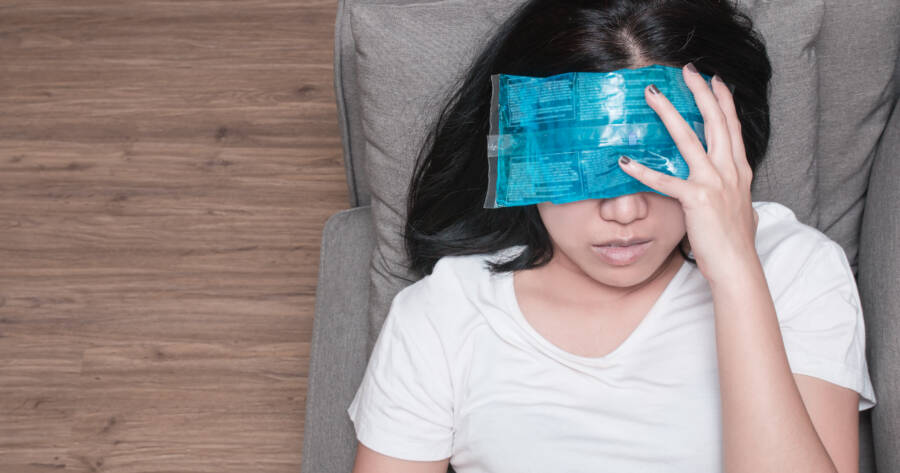When a migraine happens, it delivers pain that’s much, much worse than a typical headache. Nausea, pounding pain, and light sensitivity can all accompany a migraine. It can be difficult to work, to focus, to drive, to even sit upright when you’re experiencing one. And it’s very difficult to stop a migraine once it’s started. However, if you search online, you’ll discover that there are a multitude of ways you can stop a migraine fast. Migraines can actually be alleviated or lessened with quick and easy natural remedies that you can start immediately. With the right habits and tips, you may also be able to prevent migraines from happening. If you’re looking to stop or prevent migraines, the right DIY remedy might do the trick.
Here are five ways you may be able to stop migraines.
1. Stick to a Regular Sleep Schedule
If you’ve ever had a migraine, you know how the terrible pain can prevent you from getting a good night’s sleep. But did you know that a lack of sleep can also cause migraines to happen?
Sleep can play a significant role in causing migraines. In fact, migraines are often brought on because you didn’t get a good night’s sleep. Sticking to a regular sleep schedule and getting a full, restful night of eight hours of shut-eye can help prevent migraines from happening.
To minimize your odds of developing a migraine, try to set – and follow – a regular bedtime and a regular wake time. Follow this schedule every day of the week, including weekends. If you’re having trouble falling asleep at night, try to unwind before you head to bed. Turn off your TV, put away your smartphone, and opt for soothing, relaxing activities like a warm bath, calming music, or reading a book instead.
You should also try to minimize distractions and stressors before heading to bed. Create an environment for restful sleep by keeping TVs, work, and even bright lights out of the bedroom. Try to use your bed and bedroom solely for sleeping.
2. Have Some Caffeine
It might sound counterintuitive, but caffeine can be a huge help when you’re experiencing a migraine. Caffeine is often thought of as a product that causes headaches – but when it comes to the awful pain of a migraine, caffeine could be exactly the cure you need.
Get some caffeine into your system as soon as a migraine starts. Taking caffeine early into a migraine can help ease the pain and shorten its duration. You can try drinking tea or coffee, or another beverage that includes a small amount of caffeine.
Caffeine can be quite effective. In fact, it’s actually found in some over-the-counter pain relievers, as caffeine can help increase the effectiveness of acetaminophen.
3. Avoid Food Triggers
Did you know that what you eat could actually increase or decrease your odds of getting a migraine? Certain foods may trigger migraines, so avoiding these foods can help you feel better and prevent a new migraine from happening.
You should avoid the following foods, which are considered migraine triggers:
- Alcohol.
- Beans.
- Foods high in nitrates, like hot dogs, bacon, or sausage.
- Cheeses with a compound called tyramine, like blue cheese, feta, cheddar, Parmesan, and Swiss.
- Chocolate.
- Dried fruits.
- Processed foods.
- Freezing cold foods, like ice cream or icy drinks.
- Pickled foods.
- Cultured dairy, like sour cream and yogurt.
- MSG.
While avoiding these foods might not prevent migraines altogether, keeping these foods out of your regular diet may be able to help reduce your risk.
4. Try Temperature Therapy
Temperature therapy is a tried and true remedy for many aches, pains, and types of discomfort. You can apply cold packs or hot packs to achy joints, use them to reduce inflammation and swelling, and rely on them for sore muscles. But temperature therapy may also have a positive effect when you’re experiencing a migraine.
You can try both hot and cold therapy to stop a migraine. Try a cold pack on your forehead, or a pack of frozen vegetables, to reduce the pain of a migraine. You can also take a cold shower or apply ice. If cold isn’t doing the trick, you can try hot therapy. Apply a heating pad to your neck, the back of your head, or over your forehead. A steamy shower may also help.
When using temperature therapy, remember to apply heat or ice for just 15 minutes at the time. You don’t want to burn your skin and cause additional pain, so apply the therapy in a pattern of 15 minutes on, 15 minutes off.
5. Lower Your Stress Levels
Stress is another known migraine trigger. If you’re stressed out, the chances that you’ll develop a migraine are high. And while reducing your stress won’t do anything for a migraine that’s already in progress, it can have an impact on your odds of developing future migraines.
To avoid migraines, you’ll want to lower your everyday stress. Keeping stress under control, or at a manageable level, can help you manage the number of migraines you get. The less stressed out you feel, the less likely you are to get a painful migraine.
The following are a few tips to help you reduce your stress level:
- Slow down. Instead of focusing on the overwhelming amount of tasks you need to accomplish, cut down on how much you do each day. Eliminate a stressful task instead of squeezing another into your already busy day.
- Delegate tasks to others. If you’re feeling overwhelmed, ask for help. Handing tasks off to others can lighten your workload and your stress levels.
- Break up big projects, tasks, or even worries into smaller, more manageable pieces. Instead of trying to accomplish everything at once, focus on what you can do now.
- Take a break. If you feel stressed, go for a walk. Get away from your computer. Stretch. Practice deep breathing or meditate.
- Try to reframe the way you look at problems and situations. Instead of stressing the negatives, highlight the positives.
Putting de-stressing techniques into practice each day can lower your risk of migraines. Any time you feel stress levels rising, try to follow these tips.
Treat Your Migraine Naturally with an At-Home Remedy
With the right tips, tricks, and natural remedies, you may be able to better alleviate your migraines. You may even be able to reduce the amount of migraines you experience. The key is knowing what choices and activities can bring on a migraine, and how you can handle the symptoms of a migraine in progress.
If you’re interested in learning more about combating migraines and their side effects, you can do some research online. Search for migraine remedies, as well as ways to avoid migraine triggers. Consider different treatment options to have on hand for the next time a migraine strikes.



